RACV is committed to sharing advice and resources with Victorians of all ages, to help create safer living environments.
Here are some tips for older Victorians on how to prevent or minimise injuries in the home.
We've recently reviewed and updated our Privacy Charter, which describes how we use cookies and other technologies to understand and improve your browsing experience. By using our site, you agree to us collecting this information and to our Privacy Charter.

Information about home safety for older people and their families
Thank you for contacting us
Your reference number is
We'll contact you within 72 hours and may ask for this reference number.
RACV is committed to sharing advice and resources with Victorians of all ages, to help create safer living environments.
Here are some tips for older Victorians on how to prevent or minimise injuries in the home.
The following is general advice.
As people get older, gradual physical changes can impact the way they move. When combined with hazards in the home, these physical changes can increase the risk of falls and other injuries.
People who have experienced a fall may develop fear or loss of confidence leading to reduced physical activity. This can further reduce strength and balance, increasing the risk of another fall. Additionally, underlying health conditions and side effects of some medications can also contribute to the risk of a fall.
According to the Victorian Department of Health:
Everyone should think about reducing hazards around the home. Common hazards include:
Many simple changes can be made around the home to reduce the risk of falls or injuries.
Start by walking through your home and assessing potential risks. Ask friends or family to help – they might notice additional hazards.
Keep an eye out for the following.
Poor lighting or glare
Check that you have good lighting around the house, both inside and outside. Use a bedside lamp and night lights, and reduce sun glare by using blinds or curtains.
Slip hazards
Consider installing handrails in bathroom spaces, and use non-slip mats in wet areas and non-slip tape on step edges. Outside, clear fallen leaves, moss and other debris from paths, steps and driveways.
Clutter
Clear walkways of clutter, tape down rugs and electrical cords, remove frayed mats, apply contrast to step edges and glass doorways, attach draft excluders to doors, and check pavers or flooring for cracks.
Furniture stability and height
Make sure beds, chairs, tables and other furniture are stable and won’t tip over easily. Dressing tables, tallboys and shelving should be securely attached to the wall, and your bed height should make it easy to get in and out of.
Everyday hazards
Clean up spills straight away, wear supportive footwear and keep everyday items in easy-to-reach places.
It’s great to be handy around the home and stay on top of maintenance jobs, but it’s important to stay safe. As we age, we can lose muscle strength and balance, which can impact our ability to perform household tasks that we used to be able to do.
According to the Victorian Department of Health, people aged 65 or older are more likely to suffer a serious injury from a ladder fall, and the risk of falling increases with age. Ladder falls can result in serious injuries and a long recovery time. Even a fall of one to 2 metres is enough to cause serious injury.
No matter your age, be honest with yourself about your skill or physical ability. Using a ladder may be unsafe if you’ve previously had a fall, or if you have health conditions that impact your balance or vision.
Delay a task if necessary, and consider seeking help from a friend, family member or professional.
Do
Don’t
Discussing home safety with older family members can be challenging.
Here are some ways to respectfully bring up this sensitive topic: